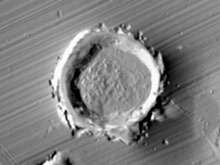Scientists analyse solar wind from moon rock

Australian National University scientists preparing for the analysis of solar wind samples from NASA’s Genesis mission believe they have already measured solar wind particles in an analysis of lunar soil.
In the latest issue of Nature, Dr Trevor Ireland and his team from the Research School of Earth Sciences at ANU detail how they found particles in which oxygen isotope measurements did not fit those of the moon, the planets, or of the earliest of meteorites.
“It was a completely unexpected result for us. We are confident that this represents the solar wind, but by no means certain,” Dr Ireland said.
“The real question our finding raises is why this solar composition appears unrelated to the composition of the planets, the largest rocky bodies in the solar system, or to refractory inclusions from meteorites which have been regarded as solar condensates. Further study of samples from the Genesis mission may have the answers.”
Dr Ireland said that it was likely the particles identified with the low oxygen abundance contained solar wind because the moon – where these samples came from – is continuously buffeted by the solar wind, which is essentially made up of charged particles ejected by the Sun.
The composition of the Sun is expected to provide significant clues as to the history of the solar system. Our planetary system represents less than 1 per cent of the mass of the solar system and any differences between the planets and the Sun must represent processes that operated in the early solar system, or represent a different mix of components.
NASA’s Genesis mission has returned to Earth samples of the solar wind for analysis. It aims to obtain precise measure of solar isotopic abundances such as oxygen, nitrogen, and noble gases.
To date, the isotopic composition of the sun has been inferred for some elements from lunar samples, but not oxygen because of its high abundance in lunar minerals.
However, using the high-resolution, high-sensitivity ion microprobe developed at ANU, called SHRIMP, the team were able to get an accurate measurement of the solar oxygen isotopes in iron metal grains. “In many ways, our measurements were our first attempt at scoping the experimental difficulties we might have in measuring the Genesis samples and we had no way of knowing beforehand that they would be analytically so successful,” Dr Ireland said.
Dr Ireland said further analysis of oxygen from other solar system bodies, such as from Jupiter’s atmosphere and from comets, would provide a greater comparative base for studies of the composition of the Sun.
“Perhaps the oxygen isotopes we found are simply telling us that the mix of components in the Sun is different to that in the planets, particularly in regard to the amount of dust versus gas. The Sun sources much of its oxygen from carbon monoxide, which is essentially lacking from the planetary bodies, which are derived from primordial dust,” Dr Ireland said.
Source: Australian National University

















